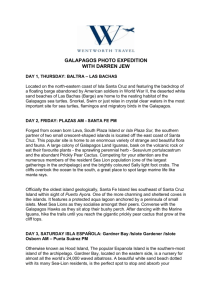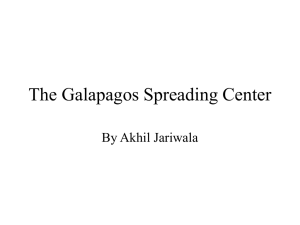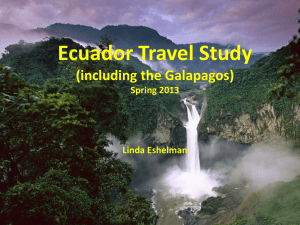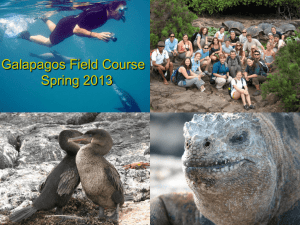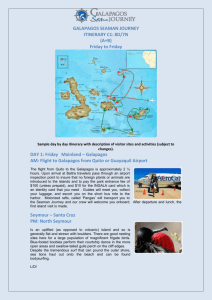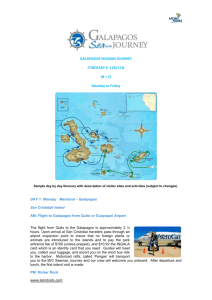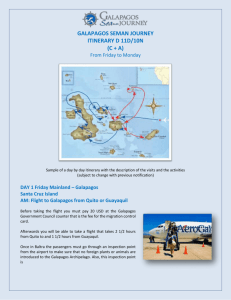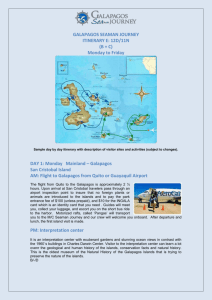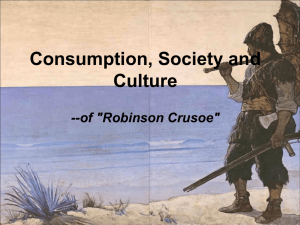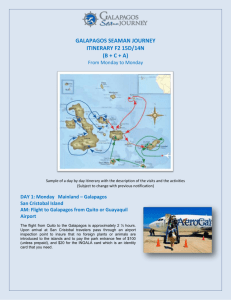GALAPAGOS SEAMAN JOURNEY ITINERARY C: 8D/7N Friday to
advertisement
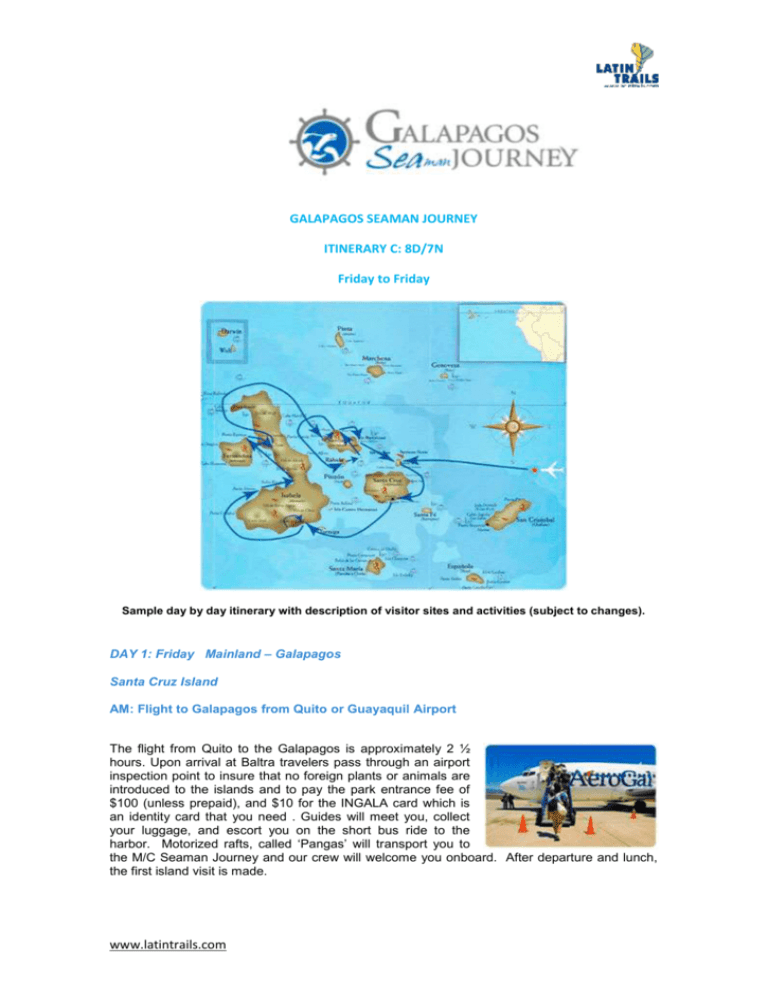
GALAPAGOS SEAMAN JOURNEY ITINERARY C: 8D/7N Friday to Friday Sample day by day itinerary with description of visitor sites and activities (subject to changes). DAY 1: Friday Mainland – Galapagos Santa Cruz Island AM: Flight to Galapagos from Quito or Guayaquil Airport The flight from Quito to the Galapagos is approximately 2 ½ hours. Upon arrival at Baltra travelers pass through an airport inspection point to insure that no foreign plants or animals are introduced to the islands and to pay the park entrance fee of $100 (unless prepaid), and $10 for the INGALA card which is an identity card that you need . Guides will meet you, collect your luggage, and escort you on the short bus ride to the harbor. Motorized rafts, called ‘Pangas’ will transport you to the M/C Seaman Journey and our crew will welcome you onboard. After departure and lunch, the first island visit is made. www.latintrails.com PM: Twin Craters The Gemelos are a pair of craters approximately 30 meters deep located on either side of the road to Baltra (island where the airport lies). The holes could be created because of a volcanic explosion or because of magma chambers inside earth. A good place to see the Galapagos hawk and barn owl is on this island. The surrounding forest is full of birds such as the vermilion flycatcher or the yellow warbler. The highlands and settlement area of Santa Cruz are worth seeing for the contrast of the vegetation with the arid coastal zones. Santa Cruz Highlands Journeying across Santa Cruz into the highlands visitors are delighted by the island's variety of life and geology. Beginning at the coast and traveling across Santa Cruz the road departs from Puerto Ayora climbing through the agricultural lands and into the mist covered forests. Santa Cruz possesses all of the various life zones present in the archipelago. As you travel through these zones birders are enchanted. Whether it's the bright red feathers of a vermillion flycatcher or one of Darwin's Finch almost every bird present in the islands can be found here. Santa Cruz offers excellent opportunities for viewing wild Galapagos Tortoises. Tracking tortoises is not the only exciting activity to be found in the highlands. There are also plenty of lava tubes, sinkholes and craters to explore. Theses eerie formations offer a fascinating hike into the belly of the island to view its volcanic make-up. L/D DAY 2: Saturday Galapagos Cruise Isabella Island AM: White Tipped Reef Shark Canal A delightful place reached by a nice zodiac ride. "Tintoreras” are small islands in front of Puerto Villamil coast. There is Heron lava on the lookout on mangrove branch, and Galapagos penguin and sea lion often pop out on shore. White-tipped reef sharks are fairly common in the archipelago. Their name in Spanish is Tintorera, thus the name of this site as they are always found here resting in the shallow waters. PM: Wall of Tears The Wall of Tears is a historic site in Isabela. Between 1946 and 1959 Isabela was a penal colony, where prisoners build a wall with huge blocks of lava as punishment. The wall is 100 meters long and 7 meters high. Due to the arduous labor and harsh conditions in which the prisoners lived, this site is known as the wall of tears. A set of stairs provides a bird's eye view of the wall and the surrounding landscape. You can still see the cement foundations of the USA base dating back to the Second World War. B/L/D www.latintrails.com DAY 3: Sunday Galapagos Cruise Isabela Island AM: Punta Moreno Punta Moreno is located on the north coast of Isabela Island between the volcano Sierra Negra and Cerro Azul volcano. The trail runs along a lava flow Pahohoe (solidified lava in the form of corrugated or an accordion) into a complex of coastal lagoons, its main attraction are several species of birds which can be found around this lakes and mangroves PM: Elizabeth Bay This is a marine visitor site, the excursion is carried out in a zodiac and so there is no landing point. Your zodiac ride starts with a visit to the Marielas islets where there is the largest and most important penguin colony in the Galapagos Islands. The excursion continues into the cove that is surrounded by red mangroves where you can admire their red roots and green leafs. It is here that you are able to observe sea turtles, flightless cormorants, spotted eagle rays, golden rays, brown pelicans, and sea lions. Frequently visitors have been able to see Galapagos hawks soaring overhead while schools of Pompano and Dorado fish swim below B/L/D DAY 4: Monday Galapagos Cruise Fernandina Island / Isabella Island AM: Espinoza Point Espinoza Point is a place famous for its large colonies of marine iguanas and as the habitat of unique species like the flightless cormorant, Galapagos penguin, Galapagos hawk, and Galapagos snake. PM: Tagus Cove, Tagus Cove, a tour along the cliffs in a zodiac will give the visitors a good chance to see the Galapagos penguin, the flightless cormorant and other sea birds. From the landing dock it is about a 30 minute hike along the trail up to the top of the clif from where you can view Darwin Lake, an uplifted ultrasaline lake saltier than the sea. You can also see several volcanoes from this location. Look carefully at the graffiti on the surrounding cliffs of the cove, it has been written by pirates, whalers and bucaneers in past centuries. www.latintrails.com DAY 5: Tuesday Galapagos Cruise Santiago Island AM: Playa Espumilla / Bucanero Espumilla beach is located in northern coast of Santiago Island in James Bay. During the last presence the El Niño phenomenon, one of the two lagoons in this site, underwent a process of sedimentation, thus causing the disappearance of a representative colony of flamingos. The main attractions are the palo santo forest and the marvelous. The beach is an important site for nesting marine turtles. PM: Puerto Egas, Santiago Island Its black beach is located at the west side of the island and is the main attraction of the island. Their volcanic tuff deposits have favored the formation of this special black sand beach. This site is called Puerto Egas, because there was an attempt of company of Hector Egas, to start the exploitation of salt, which failed because the price of salt in the continent was very cheap, and did not justify its exploitation in Galapagos. The project was abandoned and they left their infrastructure. B/L/D DAY 6: Wednesday Galapagos Cruise Rabida / Chinese Hat AM: Rabida Rábida Island is unique because the red color of the rocks and sand. The volcanic material in this island is very porous and external factors as rain, salt water, and sea breeze have acted as an oxidizing agent. A short walk along a trail lead you to a coastal lagoon behind the beach which permits you to observe the land birds such as finches, doves, yellow warblers, and mocking birds. At the lagoon there is a colony of flamingos. PM: Chinese hat This is a small islet (1 sq km) located just off the southeastern tip of Santiago Island. It is a recent volcanic cone, shaped like a Chinese hat when seen from north side. On the west you can see lava formations, formed under the sea and raised upward, this is why coral heads are found on the lava. This is an excellent visit for interpretation of geological features such as lava tubes and lava flows. The landscape is covered by sea lions colonies, marine iguanas, and Galapagos penguins. B/L/D www.latintrails.com DAY 7: Thursday Galapagos Cruise Santiago Island AM: Sullivan Bay Santiago, also called James, or San Salvador Island, is located in the west central part of the Galapagos archipelago. It is the fourth largest island in the archipelago (following Isabela, Fernandina and Santa Cruz). Along with some of the large western volcanoes of Isabela and Fernandina, Santiago is also volcanically active, with many young flows and cones to be seen, particularly along the south, west, and east coasts. These may even be seen from the summit of Darwin Volcano and from space. A number of historic eruptions have been reported over the last 2 centuries. Santiago actually consists of two coalesced volcanoes: a typical shield volcano on the northwest end and a low, linear fissure volcano on the southeast end. PM: Bartolome Bartolome Island is situated across Sullivan Bay. It has an altitude of 114 meters, from where we can observe one of the most beautiful sceneries of the Galapagos Islands such as: Volcanic cones, lunar-like craters, lava fields, and the famous Toba formed pinnacle eroded by the sea. There is very little vegetation on this island. It has two breathtaking beaches where marine turtles exist and at the base of the pinnacle, as well as a very small colony of Galapagos penguins. B/L/D DAY 8: Friday Galapagos Cruise Santa Cruz Island AM: Bachas Beach These two small beaches are found to the West of Turtle Cove. Their sand is made of decomposed coral, which makes it white and soft, making it a favorite nesting site for sea turtles. Behind one of the beaches there is a small brackish water lagoon, where occasionally is possible to observe flamingos and other coastal birds, such as black-necked stilts and whimbrels. The other beach is longer, but it has two old barges that were abandoned during the Second World War, when the USA used Baltra Island as a strategically point to protect the Panama Channel. After the morning excursion you will be taken to the airport for your flight to the mainland. B/-/Transfer to Baltra airport Flight to Quito or Guayaquil www.latintrails.com

